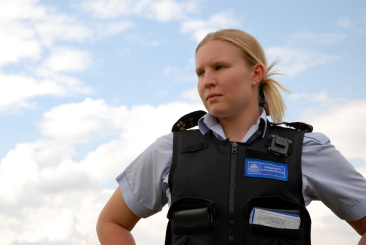|
|
| Women in Corrections |
| By Terry Campbell, Professor, Purdue University Global |
| Published: 05/11/2015 |
 Our topic this month looks at “Women in Corrections.” As you know, the corrections field has traditionally been male dominated. However, due to Federal Court Rulings and State Legislation, this has changed over the years. “The world has changed. If we look at corrections 20 to 30 years ago, the types of behaviors we rewarded and promoted people for, are the behaviors we sometimes discipline people for today. We value treating people the right way; this is not a function of gender.” (Patricia Caruso, Director, Michigan Department of Corrections).
Our topic this month looks at “Women in Corrections.” As you know, the corrections field has traditionally been male dominated. However, due to Federal Court Rulings and State Legislation, this has changed over the years. “The world has changed. If we look at corrections 20 to 30 years ago, the types of behaviors we rewarded and promoted people for, are the behaviors we sometimes discipline people for today. We value treating people the right way; this is not a function of gender.” (Patricia Caruso, Director, Michigan Department of Corrections).
The correction field is steadily increasing the number of female officers, supervisors, and administrators. Females are proving themselves as successful officers and leaders in the corrections field. They have worked very hard to be recognized over the years and overcame many hurdles and barriers. These early female staff set the tone and direction for female officers today. Overall, female staff has very good interpersonal skills and are more effective than their male counterparts in problem solving. Additional research review reflects some additional positive traits and skill sets females provide:
My personal observations and corrections background allowed me to promote the first female assistant warden at a male prison. This individual had an extensive corrections and training background. She possessed the necessary skill sets, communicated effectively, responded well in addressing the daily challenges faced in corrections, and presented a calming effect with the inmate population. Now you may ask, was she promoted because she was a female? The answer is no! She had the credentials and provided the best interview. She earned this promotion and exceeded all expectations. Later, this individual was promoted to warden at a male institution where she continued to excel. The 2006 US Bureau of Labor Statistics provided some interested statistics for review.
There are more females in the United States than males and more females will possess more college hours and degrees than men. The opportunity for entry level positions and upward mobility are very favorable for females. This is an ideal opportunity for female promotional advancement in corrections. Along with this, females must prepare themselves for advancement. This can be as simple as reviewing the job description you are interested in and ensure you know what the qualifications are, including experience and education. You are advancing your career opportunities and this can be a goal. Work toward completing those requirements and be prepared when the time arrives for an interview. Females are going to play an important role in the future of corrections. Many females pioneered corrections to establish females in the workplace. Now, female staff has an obligation to continue setting the tone and directions for other females to take this to the next level. I provided several references below for your review and consideration.
Thanks and good luck with your career. Terry Terry Campbell is a criminal justice professor at Kaplan University, School of Public Safety and has more than 20 years of experience in corrections and policing. He has served in various roles, including prison warden and parole administrator, for the Arkansas Department of Corrections. Terry may be reached at tcampbell@kaplan.edu. Other articles by Campbell |
MARKETPLACE search vendors | advanced search

IN CASE YOU MISSED IT
|


Comments:
No comments have been posted for this article.
Login to let us know what you think